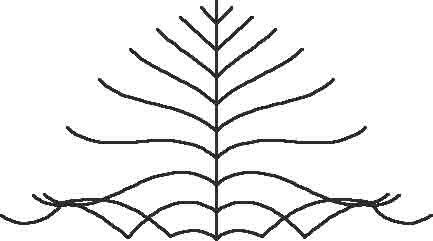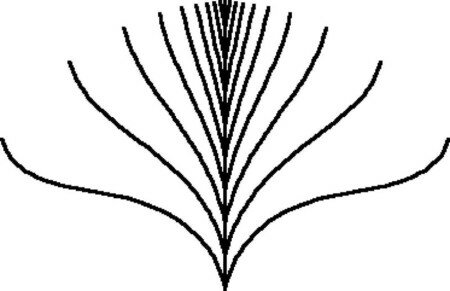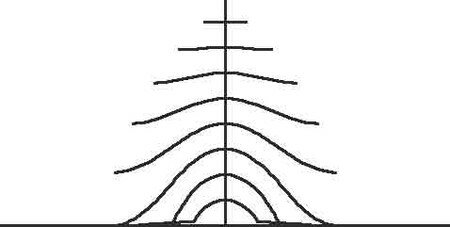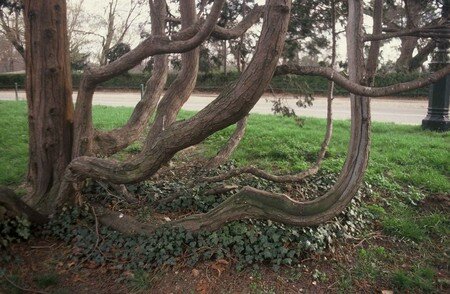Equilibrium shape of a tree branch.
BIOMECHANICS. - Equilibrium shape of a tree branch.
The shape of tree branches is computed using the theory of flexure of beams. Numerical computation is used and takes into account large displacements and growth. The coupling between elastic bending and growth results in a branch shape having an inflection point connected with a permanent deformation.
The study of stresses in living materials has been the subject of
many papers. For example the stresses due to anisotropic growth [1],
influence of stresses on growth [2], and even viscoelasticity [3] or
plasticity. The influence of gravity on growth is known under the names
of gravimorphism [4] or geotropism [5]. The proportions of trees have
been found to be limited by elastic criteria to stand under their own
weight [6]. Growth stresses and particularly those due to reaction wood
play an important role in the mechanics of trees [8], but this paper is
focused essentially on the physical influence of gravity. Growth
stresses are predominant in the trunk of a vertical tree, where
gravitational forces creating nearly hydrostatic pressures may be
neglected [8]. In branches, where bending is dominant, stresses due to
gravitational forces are much larger than in the trunk. In this
paper, growth stresses will be considered as a distinct phenomenon that
will not be taken into account in a first approximation.
A forest
tree that has been shifted from its normal upright position during a
storm will probably grow straight again. Reaction wood may force the
tree to an upright position again, but bending strain was not found to
affect radial xylem growth in Douglas-fir [5]. Old branches have an
inflection point and their curvature remaining almost unchanged when
cut, their deformation is permanent. It is often not possible to
straighten these branches without breaking them.
In the
absence of gravity a branch would probably grow straight in the
direction of light. With growth rings of constant thickness and a
constant yearly increase in length, the shape of a branch would be a
cone. Trees may be considered as structures made of beams (dead
branches) subjected to gravity. Classical Strength of Materials
considers a beam with a given shape, applies a load and calculates the
resulting shape, slightly different from the original one for thick
beams. Thin beams may have large deflections resulting in non linear
displacement, though still elastic. To apply elasticity to a tree
branch, it is necessary to know its shape before any calculation. The
theory shows that the curvature of the bent beam has a constant
sign, there is no inflection point. Elasticity is adequate to
calculate the deflection of a branch when the changes in thickness and
length are negligible as for a branch temporarily loaded with snow or
fruits.
When the load is permanent, viscous or plastic deformation
may occur, but the coupling between the simultaneous increase of the
load and the thickening of the branch is more important. A branch bends
continuously with time, even if it thickens. Even with a constant load
there would be no decrease of the deflection when the branch thickens.
On the contrary, a decrease of the thickness of the branch, would also
increase the deflection. The process of growth being time-dependent,
the shape of a branch is a function of time. Dividing time into
infinitely small intervals, it is possible to divide each time step in
a few more steps: growth, loading and bending. Growth produces an
increase in length and thickness of the branch and therefore a small
change in geometry. Using the new geometry, the increase in load being
small, linear elasticity may be used to compute the deflection, giving
another change in geometry of the branch. The growth cycle may then be
repeated for the next time step and so on. Because of the changes in
thickness and length, the principle of superposition does not
apply directly. Therefore, the stress distribution through the branch
is no more linear and a permanent deformation occurs even if the
incremental stress distribution is linear.
Many methods have been
devised by engineers to analyse the mechanical behaviour of structures.
Numerous configurations have been solved with analytical formulae, but
they are valid only for simple geometries. With the advent of
computers, numerical methods, such as finite elements and finite
differences have been developed to calculate complicated structures.
None of them (at our knowledge), takes into account the growth
phenomenon (occurring in the same manner in the construction of
buildings as for trees). In order to calculate the shape of a branch, a
simple finite difference method has been used to integrate the
differential equation of flexure step by step along the branch and
iterated in a time marching process. At each time step,
thickness, length and deflection of the branch are adjusted to take
care of growth. Few input data are necessary: the thickness of the
annual growth rings, the annual length increase of the branches, the
growth angle, the density, the longitudinal elastic modulus of wood and
the acceleration of gravity.
The results are synthesised in a
picture of the whole tree: the young branches are at the top, almost
straight and pointing in the direction of growth. The old
branches, at the bottom of the tree, are curved and deflected towards
the bottom. Figures 1 to 3 show the influence of the growth angle.
Figure 4 differs from fig. 3 only by the growth speed: bending is more
pronounced for large trees than for small ones. The shapes of the
branches are characterised by an inflection point, not predictable with
the elastic criteria of MacMahon [6].
Fig 2: 45° growth angle.
Fig. 3: 90° growth angle.

Fig. 4: Old tree with branches grow up after touching earth.







/https%3A%2F%2Fstorage.canalblog.com%2F91%2F07%2F278444%2F11812769_o.png)
/https%3A%2F%2Fstorage.canalblog.com%2F90%2F88%2F278444%2F11950807_o.jpg)
/https%3A%2F%2Fstorage.canalblog.com%2F19%2F85%2F278444%2F11932298_o.jpg)